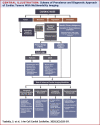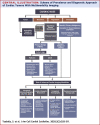Cardiac Tumors: JACC CardioOncology State-of-the-Art Review - PubMed (original) (raw)
Review
Cardiac Tumors: JACC CardioOncology State-of-the-Art Review
Sara Tyebally et al. JACC CardioOncol. 2020.
Abstract
Cardiac masses are rare, but remain an important component of cardio-oncology practice. These include benign tumors, malignant tumors (primary and secondary) and tumor-like conditions (e.g., thrombus, Lambl's excrescences, and pericardial cyst). The advent of multimodality imaging has enabled identification of the etiology of cardiac masses in many cases, especially in conjunction with information from clinical settings. This paper provides a comprehensive review of the epidemiology, clinical presentation, imaging, diagnosis, management, and outcomes of cardiac masses.
Keywords: CMR, cardiovascular magnetic resonance imaging; CT, computed tomography; FDG, fluorodeoxyglucose; PCT, primary cardiac tumor; PET, positron emission tomography; RT3DE, real-time 3-dimensional echocardiography; TEE, transesophageal echocardiography; TTE, transthoracic echocardiography; UEA, ultrasound-enhancing agent; cardiac masses; cardiac metastases; cardiac myxoma; cardiac sarcoma; cardiac tumors; papillary fibroelastoma; pericardial cyst; pericardial mesothelioma; pericardial tumors.
© 2020 The Authors.
Figures
Graphical abstract
Figure 1
Outline of the Distribution of Subtypes of Cardiac Masses by Anatomic Location The most typical locations of where different subtypes of cardiac masses are found. However, many cardiac tumours can occur in any chamber.
Central Illustration
Schema of Prevalence and Diagnostic Approach of Cardiac Tumors With Multimodality Imaging Diagnostic approach when a cardiac mass is first identified. 3D = 3-dimensional; CT = computed tomography; TEE = transesophageal echocardiography; UEA = ultrasound-enhancing agent.
Figure 2
Myxoma Left atrial myxoma in a 53-year-old man who presented with embolic events. (A) Large mobile mass (white arrow) seen on transthoracic echocardiography attached to the interatrial septum. (B) Low-attenuated, well-circumscribed mass with a smooth surface (black arrow) seen on cardiac computed tomography (CT). (C) Heterogeneous uptake in left atrial mass (white arrow) on late gadolinium imaging on cardiac magnetic resonance (CMR).
Figure 3
Lipoma Incidental finding of a cardiac mass in a 65-year-old man. (A) Ovoid mass (white arrow) on long-axis view on transthoracic echocardiography. (B) Well-circumscribed mass (white arrow) in the basal anteroseptum of the left ventricle not causing any left ventricular outflow tract obstruction on steady-state free precession (SSFP) sequences on CMR. (C) Complete signal suppression of mass (white arrow) on fat-water suppression imaging on CMR. Other abbreviation as in Figure 2.
Figure 4
Papillary Fibroelastoma Papillary fibroelastoma in a 78-year-old woman presenting with embolic events. (A) Long-axis, zoomed-in view of a small independent mobile structure (white arrow) attached to the aortic valve. (B and C) Hypodense mass (white arrows) between the right and left leaflets with frondlike papillary appearance on cardiac CT. Abbreviation as in Figure 2.
Figure 5
Rhabdomyoma An echocardiogram in a newborn who had an antenatal diagnosis of multiple cardiac rhabdomyomas and who was subsequently diagnosed as having tuberous sclerosis. Large cardiac masses extending to the right ventricular wall laterally, posteriorly, and anteriorly without evidence of right ventricular outflow tract obstruction.
Figure 6
Cardiac Paraganglioma Cardiac paraganglioma in a 72-year-old man presenting with flushing and palpitations. (A) A well-circumscribed heterogeneous mass with contrast uptake (white arrow) on cardiac CT at the superior-septal aspect of the right atrium, with significant compression of the right upper pulmonary vein. The mass is well vascularized and supplied by a branch of the right coronary artery. (B) Heterogeneous appearance on SSFP imaging on CMR (white arrow) on. (C) Avid right atrial mass (white arrow) on fluorodeoxyglucose−positron emission tomography (FDG-PET) CT. Abbreviations as in Figures 2 and 3.
Figure 7
Angiosarcoma Cardiac angiosarcoma with lung metastases in a 58-year-old man presenting with hemoptysis. (A) Heterogeneous irregular mass (white arrow) in the right atrium on echocardiography. (B) Mass involving the right atrium (black arrow), which is heterogeneous in appearance on enhanced cardiac CT with scattered areas of nonenhancing necrosis. Right-sided pleural effusion is present. (C) Large mass involving the right atrium (white arrow) that crosses tissue boundaries (infiltrating the right atrium and across into the pericardial space and into the extracardiac fat). The mass is highly vascular with additional hemorrhagic and necrotic components seen on late enhancement imaging on CMR. (D) Irregular area of intense metabolic activity (white arrow) in the right atrium on PET CT. Abbreviations as in Figures 2 and 6.
Figure 8
Leiomyosarcoma Paracardiac leiomyosarcoma in a 42-year-old man presenting with chest pain. (A) Paracardiac mass (white arrow) adjacent to the left ventricular apex that appears to be external to but closely adherent to the pericardium on SSFP imaging on CMR. (B) Paracardiac mass (white arrow) showing no late gadolinium enhancement on CMR. (C) Increased signal intensity on fat-water suppression imaging on CMR. Abbreviations as in Figures 2 and 3.
Figure 9
Primary Cardiac Lymphoma Primary cardiac lymphoma in a 72-year-old woman presenting with shortness of breath and worsening peripheral edema. (A) Cardiac mass (white arrow) shows patchy heterogeneous late gadolinium enhancement on CMR. (B) FDG PET CT pre-treatment. Increased FDG uptake within the mass (white arrow), which is replacing the right atrium and extending into the right ventricle. (C) FDG PET CT post-treatment. Complete metabolic resolution in the right atrial cardiac mass (white arrow). Abbreviations as in Figures 2 and 6.
Figure 10
Secondary Cardiac Tumor Non-small cell lung cancer with cardiac metastasis in a 48-year-old man presenting with acute anterior myocardial infarction. (A) Necrotic mass in the right middle lobe (white arrow) on cardiac CT, invading into the pericardium. (B) On resting perfusion on CMR, there is a large perfusion defect within the soft tissue mass (white arrow). The perfusion defect extends down the interventricular septum, where it likely represents the recent left anterior descending artery infarct. The mass did not enhance on first pass perfusion (not shown). (C) On late gadolinium enhancement imaging on CMR, there is an avascular core within the mass (white arrow), surrounded by high signal enhancement. Abbreviations as in Figure 2.
Similar articles
- Cardiac Computed Tomography in Cardio-Oncology: JACC: CardioOncology Primer.
Lopez-Mattei JC, Yang EH, Ferencik M, Baldassarre LA, Dent S, Budoff MJ. Lopez-Mattei JC, et al. JACC CardioOncol. 2021 Dec 21;3(5):635-649. doi: 10.1016/j.jaccao.2021.09.010. eCollection 2021 Dec. JACC CardioOncol. 2021. PMID: 34988472 Free PMC article. Review. - Cardiac and pericardial tumors: A potential application of positron emission tomography-magnetic resonance imaging.
Fathala A, Abouzied M, AlSugair AA. Fathala A, et al. World J Cardiol. 2017 Jul 26;9(7):600-608. doi: 10.4330/wjc.v9.i7.600. World J Cardiol. 2017. PMID: 28824790 Free PMC article. Review. - Contribution and performance of multimodal imaging in the diagnosis and management of cardiac masses.
Lemasle M, Lavie Badie Y, Cariou E, Fournier P, Porterie J, Rousseau H, Petermann A, Hitzel A, Carrié D, Galinier M, Marcheix B, Lairez O. Lemasle M, et al. Int J Cardiovasc Imaging. 2020 May;36(5):971-981. doi: 10.1007/s10554-020-01774-z. Epub 2020 Feb 10. Int J Cardiovasc Imaging. 2020. PMID: 32040684 - Enigma of recurrent strokes with literature review.
Kumar V, Nanavati SM, Abuarqoub A, Rushdy A, Rahman M, Komal F, Michael P. Kumar V, et al. AME Case Rep. 2017 Oct 27;1:5. doi: 10.21037/acr.2017.10.01. eCollection 2017. AME Case Rep. 2017. PMID: 30263992 Free PMC article. - Evaluation and Management of Cardiac Tumors.
Palaskas N, Thompson K, Gladish G, Agha AM, Hassan S, Iliescu C, Kim P, Durand JB, Lopez-Mattei JC. Palaskas N, et al. Curr Treat Options Cardiovasc Med. 2018 Mar 20;20(4):29. doi: 10.1007/s11936-018-0625-z. Curr Treat Options Cardiovasc Med. 2018. PMID: 29556752 Review.
Cited by
- Surgical treatment of cardiac metastatic melanoma.
Kwinta R, Kopcik K. Kwinta R, et al. Kardiochir Torakochirurgia Pol. 2024 Sep;21(3):172-176. doi: 10.5114/kitp.2024.142633. Epub 2024 Aug 29. Kardiochir Torakochirurgia Pol. 2024. PMID: 39484099 Free PMC article. Review. - Mycosis fungoides: A rare cause of giant cardiac mass.
Borderías Villarroel T, González Lizarbe S, Ruano Calvo J, Pontón Cortina A, Andia Aldana DE, Montes Moreno S, Cobo Belaustegui M. Borderías Villarroel T, et al. J Cardiol Cases. 2022 May 24;26(3):204-207. doi: 10.1016/j.jccase.2022.04.010. eCollection 2022 Sep. J Cardiol Cases. 2022. PMID: 36091614 Free PMC article. - A contradictory phenomenon of thicken pericardium and cardiac compression without inferior vena cava dilation: sign of IVC escape.
Chen TN, Zhao S, Qiao S, Han YY, Liu Q, Liu CL, Li GP, Liu T, Fu HY. Chen TN, et al. J Geriatr Cardiol. 2024 May 28;21(5):583-587. doi: 10.26599/1671-5411.2024.05.005. J Geriatr Cardiol. 2024. PMID: 38948895 Free PMC article. No abstract available. - Life-Threatening Conditions and Preoperative Complications Associated with Cardiac Neoplasm Do Not Affect Surgical Outcomes or Mortality.
Suzuki K, Sakamoto SI, Hiromoto A, Maeda M, Yamaguchi T, Yamada N, Ueda H, Matsuyama T, Osaka SI, Ishii Y. Suzuki K, et al. J Clin Med. 2024 Sep 18;13(18):5532. doi: 10.3390/jcm13185532. J Clin Med. 2024. PMID: 39337019 Free PMC article. - Surgical planning aided with 3D technologies for management of complex paracardiac tumors.
Pérez-Cualtán CE, Vargas-Acevedo C, Sánchez-Posada J, Castro-Páez C, Gutiérrez-Vargas R, Forero-Melo JF, Pérez JM, Briceño JC, Medina HM, Umaña JP, Navarro-Rueda J, Guerrero-Chalela CE. Pérez-Cualtán CE, et al. J Cardiothorac Surg. 2024 Sep 28;19(1):548. doi: 10.1186/s13019-024-03096-w. J Cardiothorac Surg. 2024. PMID: 39342312 Free PMC article.
References
- Ghosh A.K., Malcolm Walker J. Cardio-oncology. Br J Hosp Med. 2017;78:C11–C13. - PubMed
- McAllister H.A. Primary tumors and cysts of the heart and pericardium. Curr Probl Cardiol. 1979;4:1–51. - PubMed
- Cresti A., Chiavarelli M., Glauber M. Incidence rate of primary cardiac tumors: a 14-year population study. J Cardiovasc Med. 2016;17:37–43. - PubMed
- Lam King Yin, Dickens P., Chan A.C.L. Tumors of the heart: a 20-year experience with a review of 12 485 consecutive autopsies. Arch Pathol Lab Med. 1993;117:1027–1031. - PubMed
- Butany J., Leong S.W., Carmichael K., Komeda M. A 30-year analysis of cardiac neoplasms at autopsy. Can J Cardiol. 2005;21:675–680. - PubMed
Publication types
LinkOut - more resources
Full Text Sources











